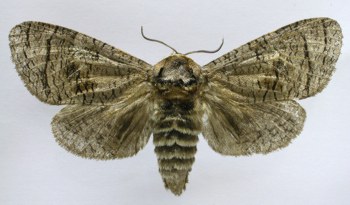Pests
Cossus cossus L. - Goat Moth
Systematic position.
Class Insecta, order Lepidoptera, family Cossidae, genus Cossus.Biological group.
This is a polyphagous pest of fruit cultures and foliaceous trees.Morphology and biology.
The moth wingspan reaches 75-100 mm, the males are somewhat smaller. Fore wings gray-brown, with indistinct gray-white pattern of numerous wavy lines. Hind wings gray-brown, more monochromatic. Thorax is brownish-gray, with velvety-black transversal stripe. Abdomen is thick, dark gray, with dense pale-gray hair-like scales on hind margin of each segment. Eggs are light-brown, oblong, 1.2-1.7 mm. Caterpillar is pink or cerise right after hatching, becoming brown-red during the last instar, with darker dorsum and black head, 80-120 mm in length. Caterpillars of different instars winter 1-2 times in gnawed-out chambers plugged with wood dust, inside tree trunks. Hatched caterpillars stay together, boring under bark and forming a common hole on phloem surface. Later, the young caterpillars cause damage to phloem and cambium, making numerous communicant holes filled with wood dust and excrements. In these holes they molt 3-4 times before wintering, hibernating during the 4-5th instars. After the first wintering, each caterpillar makes separate holes deep into wood and toward root of the trunk where it continues to develop. The holes of older caterpillars are big, widely oval, 12-16 mm in diameter. Before pupation, usually at the end of summer or in autumn, the caterpillar abandons tree trunk, goes into ground or an old stub where it plaits a dense silk cocoon, intertwining threads with soil particles. Pupation occurs in early spring. Development of pupa lasts 2 to 6 weeks. In northern areas of the European part and in Siberia the caterpillars do not abandon the tree trunk in autumn but gnaw out a chamber at the end of the hole and build a cocoon of wood dust where they winter once again. In spring older caterpillars continue feeding until June. Then they abandon the trunk, go in ground, and pupate. Before the moth appears the pupa breaks through the cocoon, moves to an outlet and then protrudes. Females lay 700 to 1000 eggs in bark cracks in large groups up to 230 eggs in a batch, and cover them with sticky excretions that harden quickly in the open air. Development of eggs lasts 12-16 days.Distribution.
This species is distributed in Western Europe, the Mediterranean, Northern, Western, and Southern China. In the former USSR it is found in the following places: forest and forest-steppe zones of the European part, Siberia, the Caucasus, Transcaucasia, Central Asia and the Far East. In the steppe zone it is found in the following places: flood-plain forests, field-protecting forest belts, gardens and parks.Ecology.
Duration of the development of one generation is 2-3 years in northern areas of the European part and Siberia; 1 year in Crimea and the Caucasus; 2 years in the Primorskii Territory. Moth flight lasts from the end of May until the beginning of August in the middle belt of the European part; from mid-April until the beginning of August in Crimea and at the Caucasian Black Sea coast in early and warm springs; from the beginning of May until the end of July in Transcaucasia; from the end of June until the end of August in Buryatia and Tuva; from April until the end of June in Turkmenistan; and from mid-May until the beginning of August in Tajikistan (Gissar Valley). Moths fly low above the ground, mainly at night. They fly in well warmed and thin deciduous and mixed forests, on edges of forests, along glades and roads and in dry and raised places. Weak drizzle without wind does not reduce their activity. In the Caucasus and in Transcaucasia the species is found up to the upper border of forests; in Turkmenistan and Tajikistan it is found in oases and tugai forests along river banks and less often in mountain forests.Economic significance.
Caterpillars damage wood of pears, apple, plums, cherries, quince, apricot, walnut, persimmon, European olives, wild olives (Olea oleaster), mulberries, sea-buckthorn, and also willow, poplar, aspen, alder, ash-tree, birches, beech, oak, maple, elm (Ulmus suberosa), oleaster.Control measures.
Control measures include the whitewashing trunks, puttying wounds on trees with garden pitch, plastering of trunks with clay combined with casein glue and insecticides. Cutting down of weakened trees populated with caterpillars is recommended. For preservation of some orchard trees it is necessary to inject an insecticide solution into caterpillar holes in trunks with the help of rubber bulbs in order to prime holes with cotton wool balls treated by insecticides.Reference citations:
Chistyakov Yu.A. 1988. Cossidae. In: Kirpichnikova V.A., Ler P.A., eds. Butterflies - pests of the Far Eastern agriculture. Keys. Vladivostok: DVO AN SSSR. 55-60 p. (In Russian)Rudnev D.F. 1974. Cossidae. In: Vasil.ev V.P., ed. Pests of agricultural crops and forest plantations. V. 2. Arthropods. Kiev: Urozhai. 226-228 p. (In Russian)
Savkovskii P.P. 1976. Atlas of the pests of fruit and berry plants. Kiev: Urozhai. 207 p. (In Russian)
Vasil.ev V.P., Livshits I.Z. 1984. Pests of fruit crops. Moscow: Kolos. 399 p. (In Russian)
Zagulyaev A.K. 1994. Cossidae. In: Kuznetsov V.I., ed. Insects and mites - pests of agricultural plants. V. 3(1). Lepidoptera. St. Petersburg: Nauka. 47-51 p. (In Russian)
Zhemchuzhina A.A., Stenina N.P. 2001. Protection of garden and kitchen garden against pests and diseases (practical guidance). St. Petersburg: MiM-Del.ta. 608 p. (In Russian)


